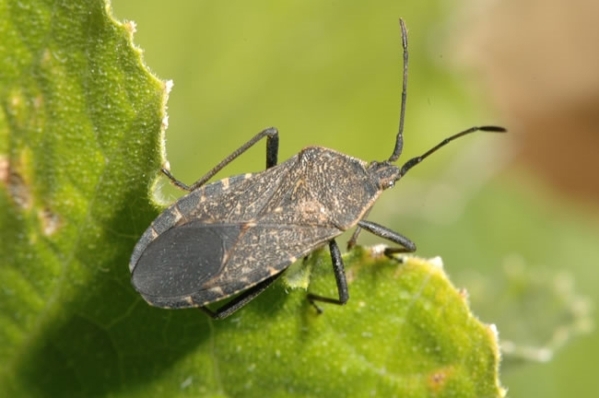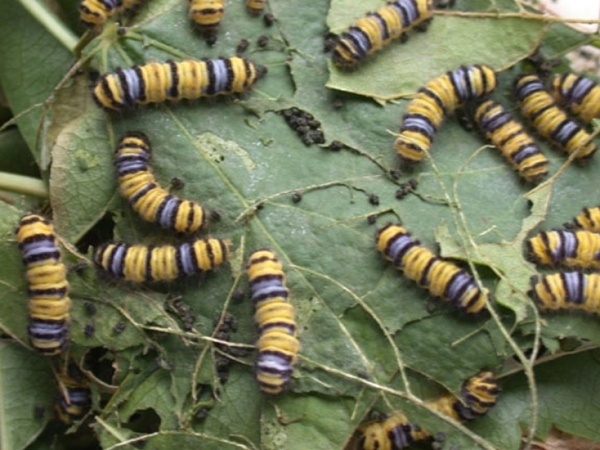Have a plan in place when bad-guy bugs show up in garden
Summer in the Mojave Desert isn't a time when locals do a lot of walking around during the day, but some organisms are remarkably active in the heat — particularly in our gardens. Not surprisingly, they are problems for the precious vegetables we are growing.
Among the most voracious insect pests is a caterpillar known as "tobacco hornworm" (Manduca sexta), a close relation to the less-common tomato hornworm. This larva of a sphinx moth or hawk moth can be four inches long and nearly a half-inch in diameter, among the biggest caterpillars in the region. Such a large insect has a large appetite.
Among its favorite foods are tomato and pepper plants. Not the fruits, but the leaves. If you see defoliated plants in your garden, it is time to start scouting the landscape. These insects are not only large and hungry, but well camouflaged. Their green color is almost indistinguishable from the green of the plant victim. The pest's droppings are noticeable for their size and shape; they are large, perhaps 1/8 inch long, dark brown and tubular, although they often appear arranged like tiny ears of corn.
Controlling these pests is crucial, because they can quickly devastate a beloved garden. It is not difficult to pick them off. If touching them is too gross, kitchen tongs can do the job. Once they are off the plant, drown them. At the end of the growing season, after removing the tomato or pepper plants, it is a good idea to rototill the soil to kill any pupae that might be underground.
The biological control agent, Bacillus thuringensis (BT) is available at many home and garden stores. Common brands include Dipel and Thuricide, but there are several. The bacteria create a compound toxic to caterpillars. It is more for prevention than cure. Soil solarization also works. For information on solarizing soil, check out the fact sheet "Soil solarization to control garden pests" (http://www.unce.unr.edu/publications/files/ho/2008/fs0829.pdf).
The grape leaf skeletonizer (Harrisina brillians) is the larva of another moth. It destroys grape leaves by eating the lower surface, leaving behind the veins and a thin layer of upper cuticle. The caterpillars travel in nearly military precision — a group will form a phalanx and eat the leaves in their path. A little over a half-inch long, they are highly visible for their bright yellow, blue and black coloration. The vivid colors are in sharp contrast to the dark gray or greenish color of the parent insects. This makes spotting the larvae easier.
Ridding vines of these caterpillars and killing the moths will lessen future infestations, and limit the damage. Remove damaged leaves especially if they have the larvae. BT is a good preventive, but some growers have found it can also help to cure the problem. Spinosad, another organic pesticide, also should be part of the grower's defense apparatus.
The third insect in this terrible trio is squash bug (Anasa tristis). It destroys squash, pumpkins, melons and most (not all) of their relations, not by chewing or stripping the leaves, but by sucking out the plant juices. This can kill small plants, and even if the plant survives, its fruit becomes discolored and unappealing.
Unlike the tobacco hornworm, which is usually found alone, or the grape leaf skeletonizer, which marches in columns across the undersides of leaves, squash bugs arrive in large numbers. Both adults and nymphs suck the sap of their victims. The adults are recognizable as gray or grayish brown, up to 5/8 of an inch long and about a quarter-inch wide. Nymphs are very similar to the adults, just smaller.
Squash bugs are not easy to control because of their sheer numbers and because the eggs can be tucked out of sight near the crown of the plant. Insecticidal soaps and horticultural oils are effective on the smallest nymphs. Other techniques for managing them include using duct tape to pick off adults, nymphs and even the eggs. This method is better during the early stages of an infestation. If the bugs seem to have gotten out of control, some home gardeners have begun using a wet/dry vacuum to suck them off the plants. Make sure there is some water in the vacuum tank so the bugs drown.
None of these control methods includes conventional pesticides, which kill pests but also other nontarget insects. If it's necessary to remove an infested leaf or plant, do not try to compost it. Composting produces heat, but it might miss an egg or several. As much as I hate to say it, bag it and place it in the garbage.
Dr. Angela O'Callaghan is the Social Horticulture Specialist for University of Nevada Cooperative Extension. Contact ocallaghana@unce.unr.edu or 702-257-5581.


















